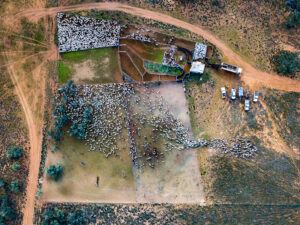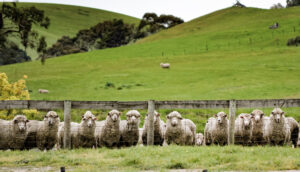Wool supply is one of the key components of the greasy wool market, and the greater supply chain, which we can monitor closely as the Australian production is well reported via the AWTA and makes up the lion’s share of merino production. With this in mind this article looks at the latest AWTA volume data to May 2024.
As the Mecardo article in early April showed (read here), year on year changes in the AWTA core test volumes for the Australian wool clip have been volatile this season. Seasonal conditions wise it has been a straight forward drought in Western Australia, complicated by government policy to shut down live sheep exports in 2028 and the accompanying uncertainty that has entailed. In eastern Australia seasonal conditions have varied through the 2024-25 season (dry spring/wet summer/varied autumn) and between regions (very dry in the southern regions).
The trends seen in sheep and lamb offtake that we last looked at in February (read here), with Western Australia continuing to offload a lot of lambs (at record levels in relation to the size of the Western Australian flock) and the sheep offtake is at contractionary levels. At a time like this it would be useful to have a current estimate of the Western Australian flock size (and makeup) but the latest available is for 2022, which is well out of date. In the east the sheep offtake is close to neutral levels with the lamb offtake pushing towards its upper limit of the past decade.
Figure 1 shows the year-on-year change in AWTA core test volumes (farm bales) for May and the three months to May by micron category. Basically 19 micron and broader volumes are down, with 16-18 micron volumes also falling in May. For the season to date overall volume is down a modest 3.1%. This fits with the average merino fibre diameter being 0.16 micron lower for the season, implying a 3.2% fall in the average clean fleece weight, using the rule of thumb that one micron change in the merino average fibre diameter correlates with a 20% change in clean fleece weight at the national clip level.
Given demand for greasy wool (and apparel fibres generally) is reported as weak, which is reflected in price, lower supply will help stabilise price.
Figure 2 shows the year on year change in farm bales by micron for the three months to May, broken into east and Western Australia. In terms of actual volume, the recent fall is clearly concentrated on the 19 to 21 micron categories with the west well and truly contributing to the fall.
The change in volume across three months helps to smooth out temporary factors and also helps us look at the market more from the supply side perspective. The relative abundance of fine merino and continued fall in broad merino volumes points to continued pressure to narrow the price differences between merino micron categories.
What does it mean?
Hopefully the rain in Western Australia continues and the east gets a spring so we can look at the effect of changing seasonal conditions on wool production. For the time being it is more of the same of recent conditions and trends. The scarcity of up-to-date information on the Western Australian flock, particularly amid challenges like drought and changes in live sheep export policy, highlights a significant oversight within the industry.
Have any questions or comments?
Key Points
- While AWTA volumes are down generally in recent months, season to date falls in eastern Australia are modest with Western Australian production reflecting the drought of the past year.
- Lower volumes will help support price.
- The fall in broad merino volumes and comparative abundance of fine merino volume will continue to put downward pressure on merino micron price differences.
- There is a lot going on in Western Australia and we do not have a current flock size (let alone make up) estimate.
Click on figure to expand
Click on figure to expand
Data sources: AWTA, ICS, Mecardo














